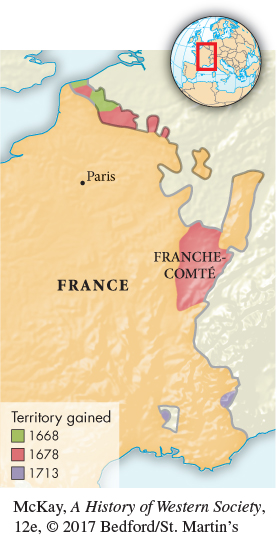A History of Western Society: Printed Page 478
A History of Western Society, Value Edition: Printed Page 461
A History of Western Society, Concise Edition: Printed Page 477
Chapter Chronology
Louis XIV’s Wars
Louis XIV wrote that “the character of a conqueror is regarded as the noblest and highest of titles.” In pursuit of the title of conqueror, he kept France at war for thirty-three of the fifty-four years of his personal rule. François le Tellier, marquis de Louvois, Louis’s secretary of state for war, equaled Colbert’s achievements in the economic realm. Louvois created a professional army in which the French state, rather than private nobles, employed the soldiers. Uniforms and weapons were standardized, and a rational system of training and promotion was devised. Many historians believe that the new loyalty, professionalism, and growth of the French army represented the peak of Louis’s success in reforming government. As in so many other matters, his model was followed across Europe.

The Acquisitions of Louis XIV, 1668–1713
Louis’s goal was to expand France to what he considered its natural borders. His armies managed to extend French borders to include important commercial centers in the Spanish Netherlands and Flanders as well as the entire province of Franche-Comté between 1667 and 1678. In 1681 Louis seized the city of Strasbourg, and three years later he sent his armies into the province of Lorraine. At that moment the king seemed invincible. In fact, Louis had reached the limit of his expansion. The wars of the 1680s and 1690s brought no additional territories but placed unbearable strains on French resources. Colbert’s successors resorted to desperate measures to finance these wars, including devaluation of the currency and new taxes.
Page 479
Louis’s last war was endured by a French people suffering high taxes, crop failure, and widespread malnutrition and death. In 1700 the childless Spanish king Charles II (r. 1665–1700) died, opening a struggle for control of Spain and its colonies. His will bequeathed the Spanish crown and its empire to Philip of Anjou, Louis XIV’s grandson (Louis’s wife, Maria-Theresa, was Charles’s sister). The will violated a prior treaty by which the European powers had agreed to divide the Spanish possessions between the king of France and the Holy Roman emperor, both brothers-in-law of Charles II. Claiming that he was following both Spanish and French interests, Louis broke with the treaty and accepted the will, thereby triggering the War of the Spanish Succession (1701–1713).

Charles II, King of Spain, and His Wife Kneeling Before the Eucharist From the royal family to the common peasant, fervent Catholic religious faith permeated seventeenth-century Spanish society, serving as a binding force for the newly unified nation.
(Musée Eucharistique du Hieron, Paray le-Monial, France/Gianni Dagli Orti/The Art Archive at Art Resource, NY)
In 1701 the English, Dutch, Austrians, and Prussians formed the Grand Alliance against Louis XIV. War dragged on until 1713. The Peace of Utrecht, which ended the war, allowed Louis’s grandson Philip to remain king of Spain on the understanding that the French and Spanish crowns would never be united. France surrendered Nova Scotia, Newfoundland, and the Hudson Bay territory to England, which also acquired Gibraltar, Minorca, and control of the African slave trade from Spain (Map 15.2).
The Peace of Utrecht represented the balance-of-power principle in operation, setting limits on the extent to which any one power — in this case, France — could expand. It also marked the end of French expansion. Thirty-five years of war had given France the rights to all of Alsace and some commercial centers in the north. But at what price? In 1714 an exhausted France hovered on the brink of bankruptcy. It is no wonder that when Louis XIV died on September 1, 1715, many subjects felt as much relief as they did sorrow.

